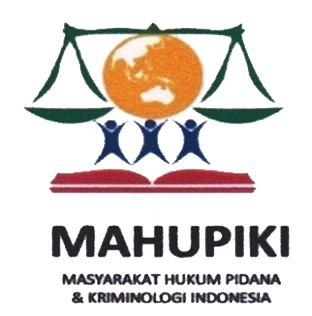The rise of the Hate Comment Phenomenon among Indonesian Teenagers in Social Media
DOI:
https://doi.org/10.35586/jhs.v2i3.5694Keywords:
Hate comment, Media Sosial, Ujaran KebencianAbstract
Abstract
Apart from the many conveniences that are felt, of course there are also negative effects from the current rapid development of technology, the rise of hate comments that occur on social media is a form of the negative impact of current technological developments. This journal was created with the aim of studying the meaning of hate comments and researching the regulations in Indonesia that regulate hate comments, and to understand more about the impact of hate comments so that hate comments can be reduced. This study uses the literature study research method in which the author seeks data and information from various types of references such as documents, both written documents, documents in the form of photographs, documents in the form of images, and documents in electronic form that can be used as sources in research process. It can be concluded that hate speech is a word, deed, writing or action that can lead to acts of violence that demean the dignity of fellow human beings, resulting in stigma from those who commit or are called perpetrators or those who are victims of these actions. hate comments that are often carried out on social media are included in hate speech. Indonesia has several regulations governing hate comments including the ITE Law, the Criminal Code, and the Chief of Police Circular Number: SE/06/X/2015 concerning Handling Hate Speech. In addition, hate comments also have some bad effects for victims. as well as perpetrators.
Keywords: Hate comment, Social Media, Hate Speech
References
Akademi. (2019). Dampak Negatif Media Sosial Bagi Masyarakat. (Blog, SMK PGRI 3 Cimahi). https://smkpgri3cimahi.sch.id/blog/quicquid-enima-sapientia-proficiscitur-idconti/
Anam, M. C., & Hafiz, M. (n.d.). Surat Edaran Kapolri Tentang Penanganan Ujaran Kebencian (Hate Speech) dalam Kerangka Hak Asasi Manusia. Jurnal Keamanan Nasional, 1(3), 341--364.
Anggraini, W. Y. (2022, 08 29). 4 Artis Korea Meninggal Bunuh Diri, Akibat Komentar Jahat Netizen. harianterbit, 1.
Ashofa, B. (2007). Metode Penelitian Hukum. Jakarta: Rineka Cipta.
Astuti, F. (2019). Perilaku Hate Speech pada Remaja di Media Sosial Instagram. (Skripsi, Universitas Muhammadiyah Surakarta, 2019). http://eprints.ums.ac.id/79538/1/NASKAH%20PUBLIKASI.pdf
Beritabeta.com. (2019). Waspada Gangguan Jiwa Akibat Sosial Media, Ada Belasan Jenisnya. https://beritabeta.com/infosehat/waspada-gangguan-jiwaakibat-sosial-media-ada-belasanjenisnya.
Fakhry, M. C. (2018). Studi Korelasional Mengenai Pengaruh Hate Speech di Media Sosial Instagram Terhadap Perilaku Cyber-Bullying Mahasiswa Universitas Sumatera Utara. (Skripsi, Universitas Sumatera Utara, 2018). http://repositori.usu.ac.id/handle/123456789/3342
Febriyani, M. (2018). Analisis faktor penyebab pelaku melakukan ujaran kebencian (hate speech) dalam media sosial. Skripsi.
Felita, P. (n.d.). Pemakaian Media Sosial dan Self Concept Pada Remaja. Jurnal Ilmiah Psikologi MANASA, 5(1), 31.
Gagliardone, Iginio, Gal, D., Alves, T., & Martinez, G. (2015). Countering Online Hate Speech. Retrieved from https://www.academia.edu/13194592/Countering_Online_Hate_Speech
Hidayat, B. D., Surono, A., & Hidayat, M. N. (n.d.). Ujaran Kebencian pada Media Sosial pada Saat Pandemi Covid-19 Studi Kasus Putusan No. 72/PID.SUS/2020/PT.DPS. Jurnal Magister Ilmu Hukum, 6(2), 33.
Kemkominfo: pengguna internet di Indonesia capai 82 juta. (n.d.). https://kominfo.go.id/index.php/content/detail/3980/Kemkominfo:+Pengguna+Internet+di+Indonesia+Capai+82+Juta/0/berita_satker.
Maulidin, M. A., Alim, S., & Sari, V. P. (n.d.). Cerdas dan Bijak dalam Memanfaatkan Media Sosial di Tengah Era Literasi dan Informasi. Jurnal Aplikasi Ipteks Untuk Masyarakat, 6(1), 1.
Sitorus, A. Z., & Irwansyah (2017). Fenomena Haters Sebagai Dampak Negatif Perkembangan Media Sosial Di Indonesia. Polyglot, 13(2), 109-121. https://doi.org/10.19166/pji.v13i2.371
Setiono. (2010). Pemahaman Terhadap Metodologi Penelitian Hukum. Surakarta: Program Studi Ilmu Hukum Pasca Sarjana Universitas Sebelas Maret (UNS).
Tvone. (2022, 2 23). Kena Mental Dihujat Netizen Karena Dugaan Pemerkosaan, Pemuda Nekat Bunuh Diri. tvonenews, 1.
Widayati, L. S. (n.d.). Ujaran Kebencian: Batasan Pengertian dan Larangannya. Bidang Hukum Info Singkat, 10(6), 3.
Yumni, S. Z. “Budaya Berkomentar Warganet di Media Sosial: Ujaran Kebencian Sebagai Sebuah Tren”,(https://egsa.geo.ugm.ac.id/2022/02/06/budaya-berkomentar-warganet-di-media-sosial-ujaran-kebencian-sebagai-sebuah-tren/
Undang-Undang Nomor 19 Tahun 2016 tentang Perubahan Atas Undang-Undang Nomor 11 Tahun 2008 Tentang Informasi dan Transaksi Elektronik.
Kitab Undang-Undang Hukum Pidana (KUHP).
Kepala Kepolisian Negara Republik Indonesia, Surat Edaran Kapolri Nomor: SE/06/X/2015 tentang Penanganan Ujaran Kebencian (Hate Speech), 1.
Downloads
Published
How to Cite
Issue
Section
License

This work is licensed under a Creative Commons Attribution-ShareAlike 4.0 International License.
Authors who publish with this journal agree to the following terms:
- Authors retain copyright and grant the journal right of first publication with the work simultaneously licensed under a Creative Commons Attribution-ShareAlike 4.0 International License that allows others to share the work with an acknowledgement of the work's authorship and initial publication in this journal.
- Authors are able to enter into separate, additional contractual arrangements for the non-exclusive distribution of the journal's published version of the work (e.g., post it to an institutional repository or publish it in a book), with an acknowledgement of its initial publication in this journal.
- Authors are permitted and encouraged to post their work online (e.g., in institutional repositories or on their website) prior to and during the submission process, as it can lead to productive exchanges, as well as earlier and greater citation of published work (See The Effect of Open Access).
Jurnal Statuta have CC-BY-SA or an equivalent license as the optimal license for the publication, distribution, use, and reuse of scholarly work.
In developing strategy and setting priorities, Jurnal Statuta recognize that free access is better than priced access, libre access is better than free access, and libre under CC-BY-SA or the equivalent is better than libre under more restrictive open licenses. We should achieve what we can when we can. We should not delay achieving free in order to achieve libre, and we should not stop with free when we can achieve libre.
You are free to:
- Share — copy and redistribute the material in any medium or format
- Adapt — remix, transform, and build upon the material for any purpose, even commercially.
The licensor cannot revoke these freedoms as long as you follow the license terms.

Jurnal Statuta licensed under a Creative Commons Attribution-ShareAlike 4.0 International License.











